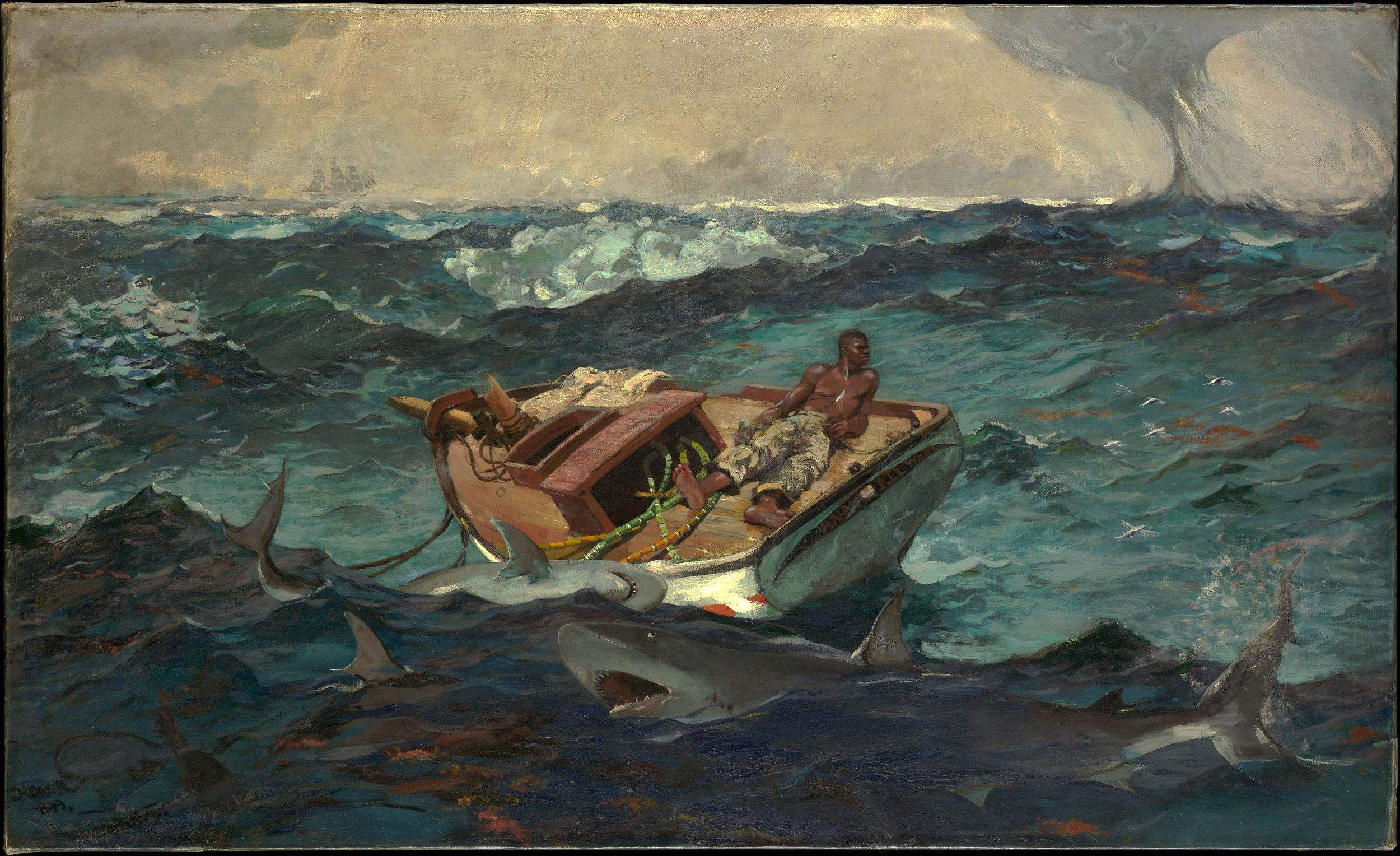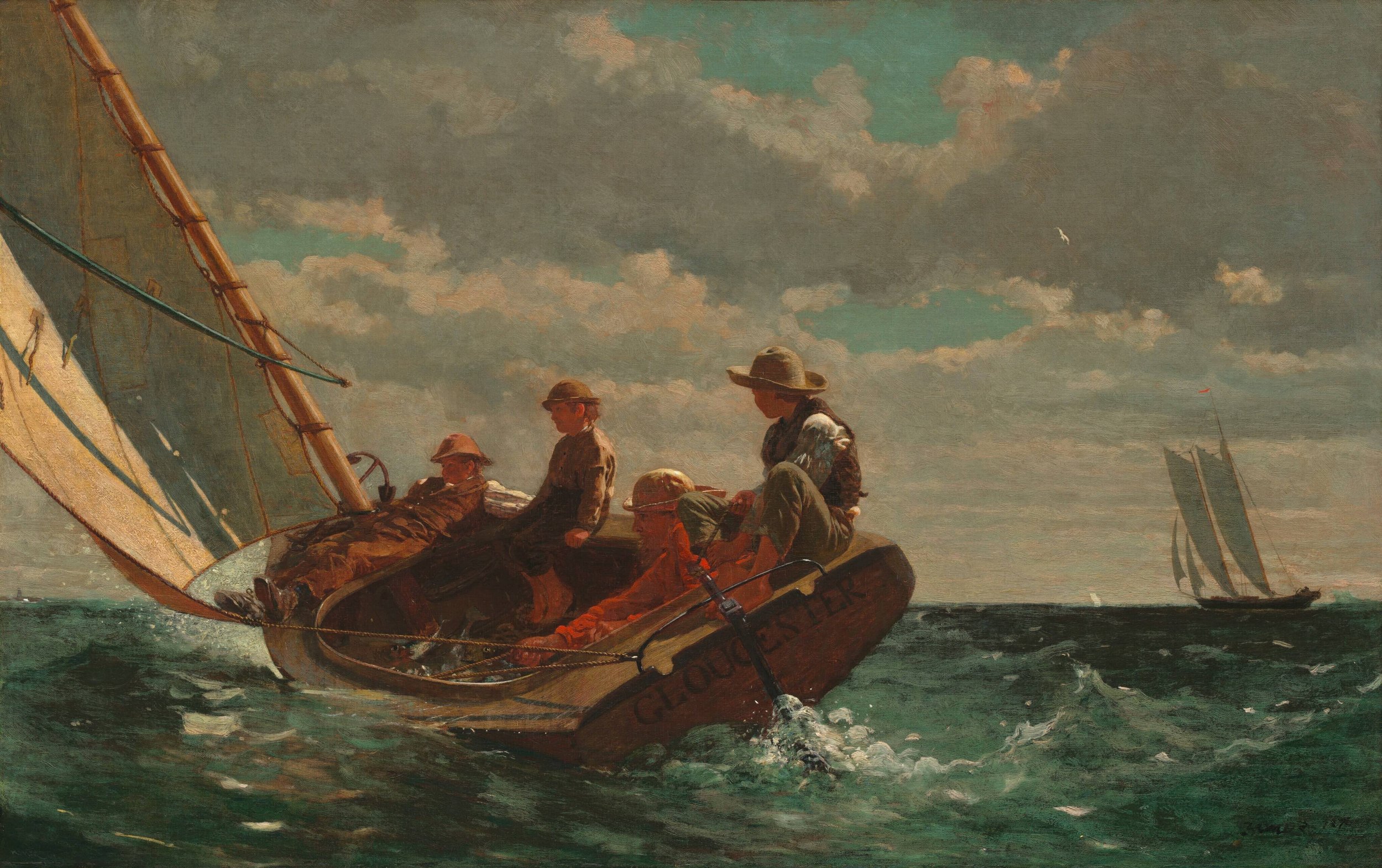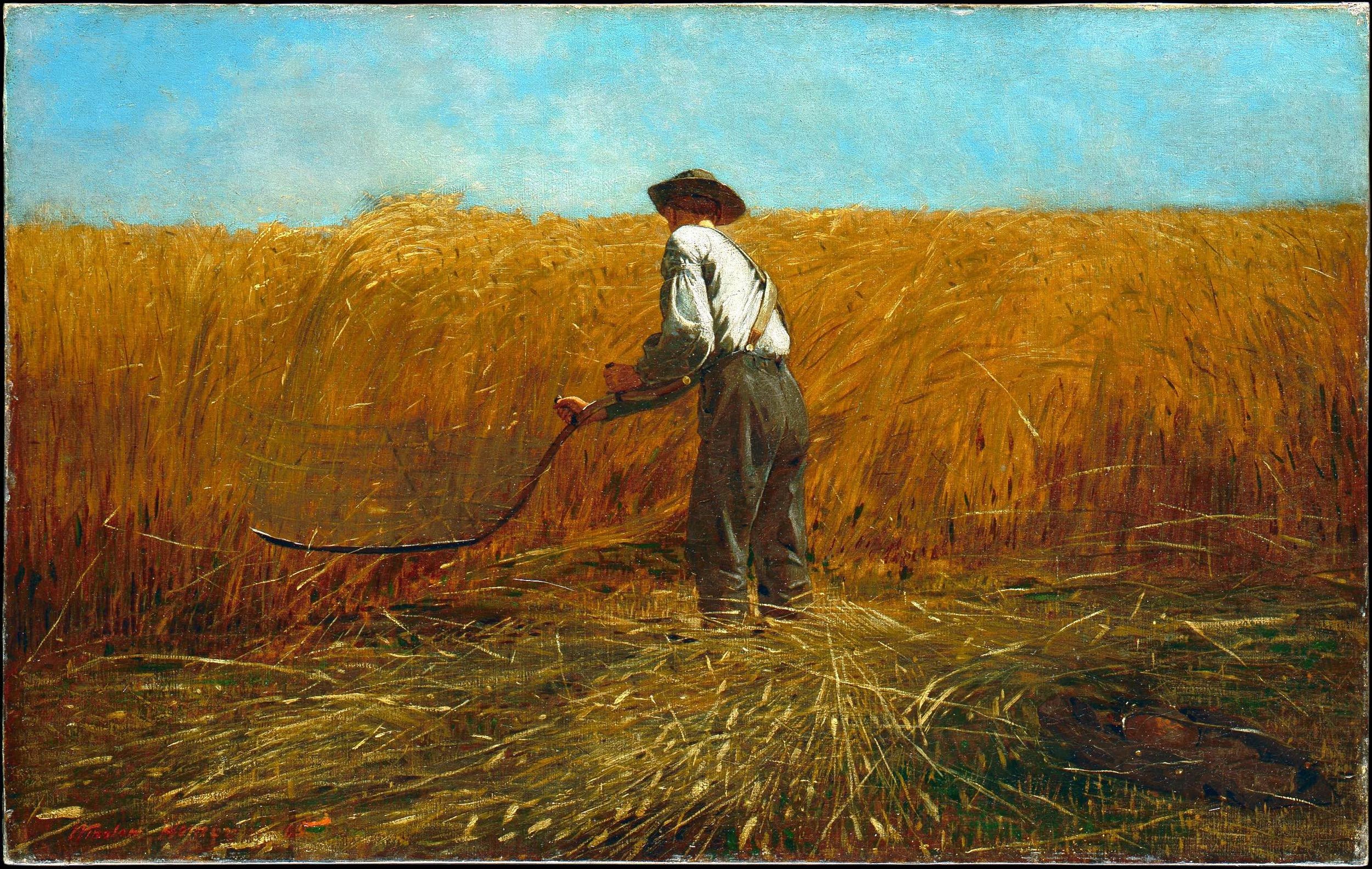THE NEW CRITERION, June 2022
On “Winslow Homer: Crosscurrents” at the Metropolitan Museum of Art, New York.
Winslow Homer (1836–1910) was an artist of few words and much action. His paintings and watercolors depict moments of contemplation often surrounded by turmoil. Man against man, man against nature, and nature against innocence are recurring themes. The beloved Yankee chronicler of the second half of the nineteenth century, largely self-taught, captured the fading light of agrarian New England to elevate his genre scenes into portraits of profound expression. He started as an artist of the Civil War. His first assignments were battlefield dispatches for Harper’s Monthly. Over his prodigious career he edited down his observations into fraught, ambiguous narratives. With daring passages of abstraction, his late seascapes, of waves crashing against rocks around his home in Prouts Neck, Maine, prefigured the twentieth century’s modern turn while remaining true to his regional vision.
Winslow Homer, The Gulf Stream, 1899, Oil on canvas, The Metropolitan Museum of Art, New York.
You can see these achievements in “Winslow Homer: Crosscurrents,” the survey now on view at the Metropolitan Museum of Art.1 Here are many of Homer’s greatest paintings in one place. Beyond over a dozen major works from the Met’s own collection, the exhibition includes such iconic pictures as Crossing the Pasture (1871–72, Amon Carter Museum of American Art, Fort Worth), Breezing Up (A Fair Wind) (1873–76, National Gallery of Art, Washington, D.C.), The Life Line (1884, Philadelphia Museum of Art), and Fox Hunt (1893, Pennsylvania Academy of Fine Arts, Philadelphia).
While containing passages of the specific, the paintings rise above the regional and anecdotal to speak to the broader themes of childhood exploration, interpersonal relations, and natural wonder. Mystery and peril vie against ingenuity and observation. From the stoic industry of The Veteran in a New Field (1865, Metropolitan Museum of Art), to the playful game of Snap the Whip (1872, Metropolitan Museum of Art), to the heroic salvation of Undertow (1886, Clark Art Institute, Williamstown, Massachusetts), we can see the preciousness of life and reminders of our own mortality.
And yet, this major exhibition leaves the artist foundering. Political baggage has been piled high. Much like The Gulf Stream (1899, reworked by 1906, Metropolitan Museum of Art), the masterpiece at the center of the show, the tiller has broken, the mast has snapped, and the cargo will not make it to shore. Contemporary hurricanes have come to churn the waters. Homer has been blown to sea. The unfortunate artist is adrift.
The conceit of “Crosscurrents” is that The Gulf Stream, a highlight of the Metropolitan’s American collection, is singularly central to the artist’s body of work. The powerful painting drew on watercolor studies Homer made over some twenty years during his winter vacations in the Bahamas, Cuba, Florida, and Bermuda. Homer sketched frequently as he escaped the Maine cold. Yet The Gulf Stream as composed back home was an outlier, his only Caribbean seascape in oil and his only one depicting a black sailor. An investigation into the development of this image might make for an interesting focused exhibit. But this is not the case: the lending and collecting powers of the Met and the National Gallery, London, where this exhibition will next be seen, are brought to bear on a full-throated revisionist survey based on a far-fetched academic thesis.
With eighty-eight oils and watercolors, this show is the largest gathering of Homer’s work since Washington’s National Gallery retrospective in 1995. It is also something of a sneering response to that prior exhibition, one that championed Homer as “America’s greatest and most national painter.” Privileging a “traditional modernist trajectory of masculine genius, innovation, and originality,” reads the present exhibition catalogue, the National Gallery show of 1995 blindly “glossed over issues of gender, race, and class in Homer’s life and art.”
Winslow Homer, Breezing Up (A Fair Wind), 1873–76, Oil on canvas, National Gallery of Art, Washington D.C.
The centrality of The Gulf Stream to “Crosscurrents” is built right into the exhibition design. Openings have been cut into the gallery walls so that the painting, situated midstream, can be seen from the introductory hall and other waypoints along the route. Arranged thematically, the survey then swirls like a gyre around this one myopic focus of the show. The point of it all is to dislocate Homer from his rooting as a Yankee artist into something of a diasporic critic of American imperialism, capitalism, racism, and environmental degradation. In this way, the exhibition’s “sociopolitical framework centered on race, politics, and environmentalism aligns with the Museum’s educational mission to share truthful and complex narratives of the past,” writes Max Hollein, the Met’s director, “advancing institutional commitments to racial reckoning and social justice.” It also helps to sell the show as a transatlantic co-production with London’s National Gallery—or, as one catalogue writer puts it, a deracinated reflection on Homer’s “North Atlantic boreal region.” As the exhibition charts a passage into contemporary waters, the heavy-handed helming capsizes the operation more than once.
A charitable understanding of what follows is that the curators of “Crosscurrents,” Stephanie L. Herdrich and Sylvia Yount, both of the Met’s American Wing, must now conform all collection highlights and exhibition programming to the strictures of diversity, equity, and inclusion. Only by “reconsidering Homer’s dramatic pictures” can we appreciate the artist’s “ability to distill challenging issues for diverse audiences, then and now,” reads the introductory wall text. The show promises that a “close study of his art” will reveal Homer’s “persistent concerns with race and the environment.” It also claims that The Gulf Stream “addresses the racial politics of the time and the imperialist ambitions of the United States.”
Winslow Homer, The Veteran in a New Field, 1865, Oil on canvas, The Metropolitan Museum of Art, The Metropolitan Museum of Art, New York.
The catalogue makes even more explicit the turbulence the exhibition seeks to stir up and the magical thinking it aims to engender. Yount invokes the show’s “multivalent title” to draw us away from the traditional “emphasis on Homer’s manly individuality,” which “sat comfortably in the turn-of-the-twentieth-century strenuous age of American imperialism.” Instead we are expected to challenge the “popular conception of him as a parochial ‘Yankee’ realist who painted mostly Northeastern subjects.” One way the show does this is by confusing Homer’s formal evolution, rejecting his powerful late seascapes, for example, as his final statements. Such a challenge, Yount continues, “became more urgent after the racial reckoning fueled by the murder of George Floyd and a reinvigoration of the Black Lives Matter social justice movement during the pandemic summer of 2020.” She concludes:
More Homer scholarship needs to critically interrogate how race and class and their structures of power weave throughout his production, grounded in the afterlives of transatlantic slavery, plantation economies, and cultural dispossession, scarred and defined by violence and survivance.
Interrogate? Survivance? An activist idiom inflects much of the language here and distorts the show’s attempt to frame our observations. Any understanding of Homer’s biography or his formal developments must be extracted from these politically charged semantics. For an understanding of Homer’s paint handling, for example, we must turn to “The Various Colors and Types of Negros: Winslow Homer Learns to Paint Race,” the catalogue essay by Gwendolyn DuBois Shaw. Here we read that Homer at first indulged the “tropes of Black indolence and grotesque musicality”—for example, in painting the black banjo player of Defiance, Inviting a Shot before Petersburg (1864, Detroit Institute of Arts)—with the same pigments that minstrels used for blackface:
In the middle of the nineteenth century, the hands of White performers working in minstrelsy and those of White painters, like Homer, were often stained with the same substances, as pigments like burnt cork and lampblack were mixed with various types of nut or seed oil for easel painting or cocoa butter for stage makeup. Both . . . [sought] to simulate racial Blackness.
In an art history of identity politics, stained hands must be racist. So is the weather: “The weather is the totality of our environments; the weather is the total climate; and that climate is antiblack,” writes Christina Sharpe, a black studies professor at Canada’s York University, of The Gulf Stream, as quoted in the catalogue of “Crosscurrents.” Peter H. Wood, a professor of history at Duke University, similarly imputed that “at the heart of this storm was black disenfranchisement.”
Through the lens of identity politics, how could The Gulf Stream not be freighted with geo-racial commentary? The painting depicts a black man in extremis in the waters of the Middle Passage. Stalks of sugarcane seem to bind him. He has set off at a moment in history when Cuba has been liberated from Spanish oppression. Sharks encircle him in a way that recalls Slave Ship, Turner’s 1840 interpretation of the massacre of the Zong—a painting that Homer saw and admired. A waterspout and a tall ship, both on the horizon, suggest the possibilities of salvation or ruin.And yet, the painting is a concatenation of the same maritime images and themes that Homer explored his entire career. The framing of the ship and the posture of its passenger most recall Breezing Up. The lay of the sharks repeats images from his tropical watercolors of 1885. As Homer reworked the painting between 1899 and 1906, he also added the name “Anna” to the stern of the small catboat and identified its home port as “Key West.” That the ship does not hail from Havana or Nassau but an American island, in fact, pulls this image away from international commentary into a more domestic setting. It also helps locate this sailor in the Florida Straits—in the Gulf Stream, to be precise, which is all Homer said the painting was ever about if he said anything about it at all.
“Do not smell of this, but stand off!” Homer admonished his dealer. In tiny lettering, he even printed a warning into the left-hand corner of The Gulf Stream, “At 12 feet you can see it.” In other words: If you can read this, you are too close.
Homer was vehemently resistant to over-interpretation. In the 1870s, his friends in the Tile Club labeled him the “Obtuse Bard.” “Don’t let the public poke its nose into my picture,” he said. In 1902, when his dealer at M. Knoedler & Co. asked about the meaning of The Gulf Stream, he replied to the “inquisitive schoolma’ms”:
I have crossed the Gulf Stream ten times & I should know something about it. The boat & sharks are outside matters of very little consequence. They have been blown out to sea by a hurricane. You can tell these ladies that the unfortunate negro who now is so dazed & parboiled, will be rescued & returned to his friends and home, & ever after live happily.
Homer was an avid sportsman, hunter, and fisherman. His work reflected the realities of life lived by the current, the wind, and the tide. His simple reply to those “inquisitive schoolma’ms” looking for more might be the same now as it was then: “I regret very much that I have painted a picture that requires any description.”
“Winslow Homer: Crosscurrents” opened at The Metropolitan Museum of Art, New York, on April 11 and remains on view through July 31, 2022. The exhibition will next be seen at The National Gallery, London (September 10, 2022–January 8, 2023).



